The Featured Creatures collection provides in-depth profiles of insects, nematodes, arachnids and other organisms relevant to Florida. These profiles are intended for the use of interested laypersons with some knowledge of biology as well as academic audiences.
Introduction
The redlegged ham beetle (Necrobia rufipes) is a predaceous and scavenging beetle that feeds on a variety of decaying organic matter, especially that of high protein and fat content such as dead vertebrate animals, and some of plant origin, such as copra, nuts, and palm kernel. The redlegged ham beetle is of economic importance as a pest of stored products and has relevance to forensic entomology. Other common names include the ham beetle, the copra beetle or bug, and “paper worm” (Simmons and Ellington 1925).
Distribution
Necrobia rufipes is cosmopolitan in distribution (Hasan et al. 2020a).
Description
Egg
The egg is small, approximately 1 mm long, and translucent, shiny white. It is cylindrical with tapered ends that look like a tiny grain of rice (Hasan et al. 2020a, Weier 2011). They are often laid in clusters in dry cracks and crevices on or near food sources to protect them from cannibalism and predation (MPWG 2015).
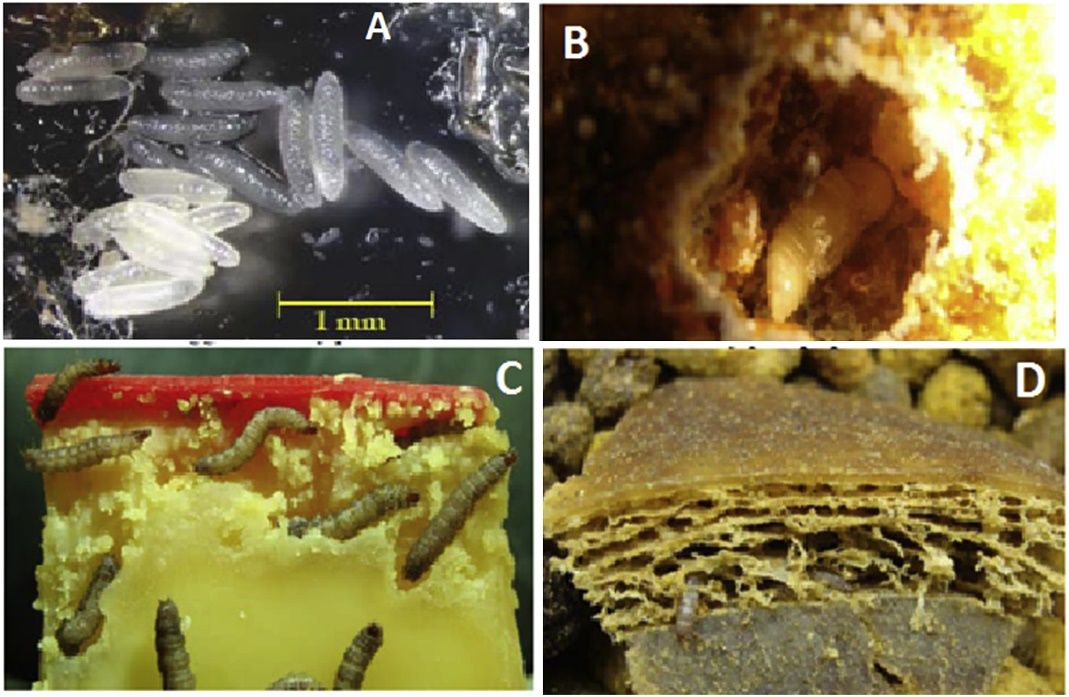
Credit: Hasan et al. (2020a)
Larva
The larva has a dark red-brown head region, three pairs of legs, and a long abdomen that ranges in color from tawny brown to dirty off-white, with the end of the abdomen dark and sclerotized, with a pair of small projections (urogomphi) coming off the rear. They have small, light-colored hairs all along the body. They can reach up to 10 mm in length and avoid light (Weier 2011).
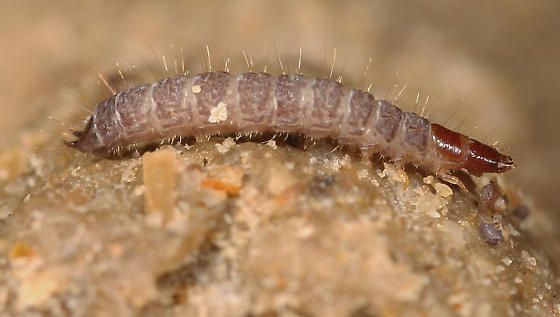
Credit: Mario David Bazan, Bugguide.net. https://creativecommons.org/licenses/by-nd-nc/1.0/
Pupa
The pupa forms a silken case, or pupal chamber, to pupate in. This may be found in nearby cracks and crevices if the food sources have a high moisture content or are oily; puparia in dried foods may be located in the foods and incorporate particles of the food in the puparium for camouflage (Holcomb 2006).
Adult
Adults are vibrantly colored when compared to most other stored product pest beetles (Holcomb 2006). The adult’s head, thorax, and abdomen are a shiny metallic blue-green color, with the legs an orange-red. Antennae are also red with a distinctive black club on the last three segments. The thorax is rounded and narrower than the base of the wing covers, or elytra. The tip of the abdomen is not covered by the elytra and can be seen from above, or on the dorsal side. The body is covered with bristle-like hairs, and the hairs of the female that are located on the wing covers are pointing forward, a distinguishing feature to differentiate females from males (Hasan et al. 2020a). The adult length is typically around 4.5 mm (~3/16 in) in length. The adults can fly and are avoidant of light. They are most often seen crawling on their food sources but will readily fly if disturbed (Holcomb 2006).
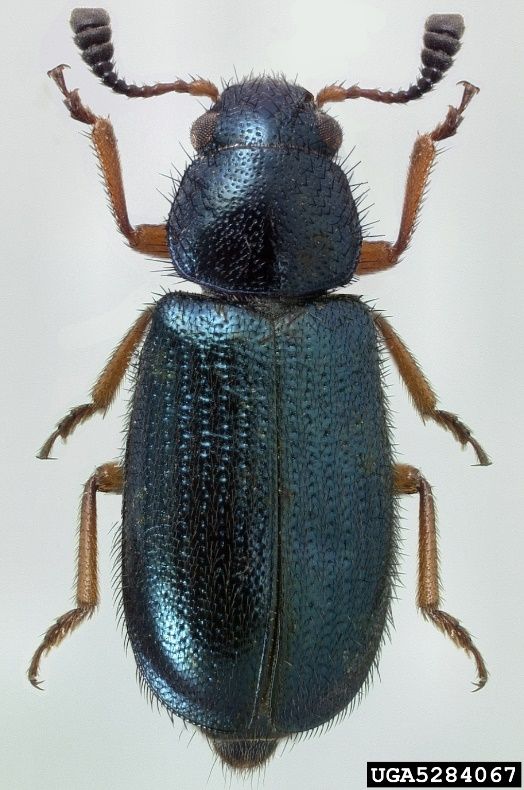
Credit: Michael C. Thomas, Florida Department of Agriculture and Consumer Services, Bugwood.org
There are a few species that have similar morphologies. The redlegged ham beetle is sometimes confused with the red-shouldered ham beetle, Necrobia ruficollis (Fabricius), which has a red-colored head, thorax, and wing base top. Another is the cosmopolitan blue bone beetle, Necrobia violacae (Fabricius), which has black or bluish legs and antennae (Hasan et al. 2020a).
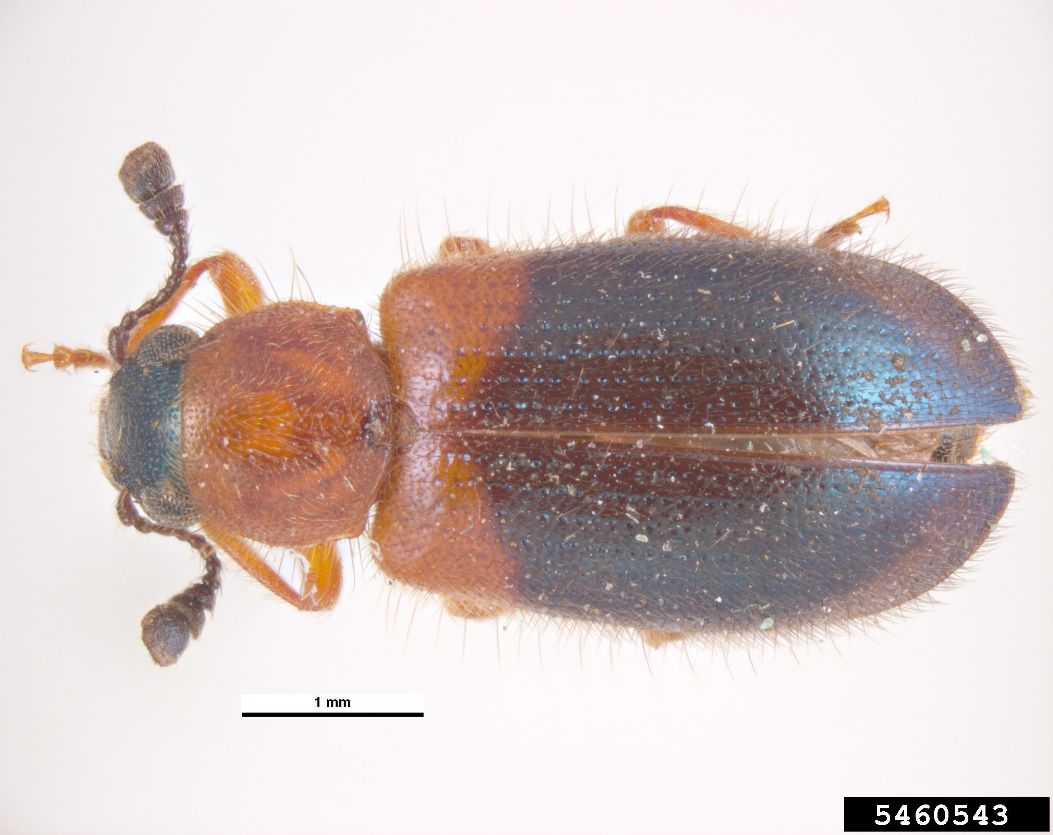
Credit: Pest and Diseases Image Library, Bugwood.org
Life Cycle and Biology
The redlegged ham beetle is a predaceous beetle that feeds on a variety of other stored product pest species, including other redlegged ham beetles, and will also consume stored products that have high protein and fat content. Adults mate within days of emergence. The female may live up to 12 months and can lay between 100 and 3,000 eggs in crevices near food sources (MPWG 2015). Necrobia rufipes exhibits complete metamorphosis as egg, larva, pupa, and adult. The eggs typically hatch in four to five days under ideal conditions. Emerging larvae will eat their own eggshells and will eat any other eggs they find nearby before burrowing into the food source (Simmons and Ellington 1925).
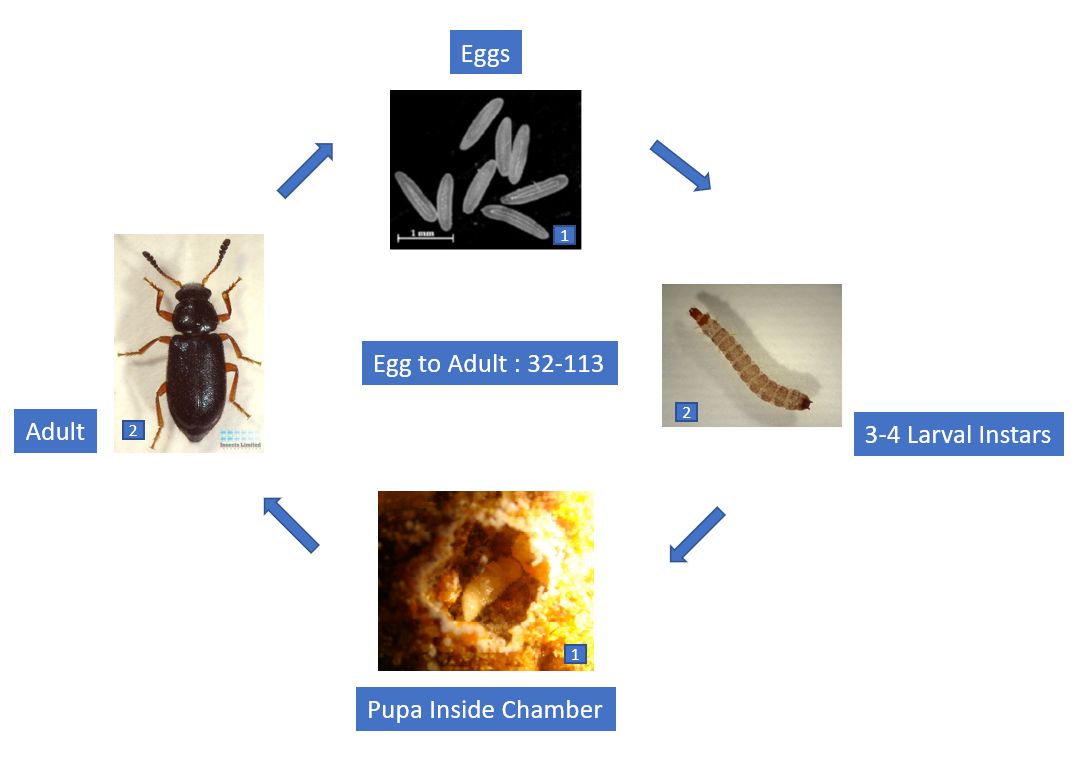
Credit: (1) from Hasan and Phillips 2010, (2) E. Estabrook, Insects Limited
Food sources are varied and can include cured and dried meats (primarily ham and fish), cheese, cashews, coconut (copra), oil seeds such as palm, bone, taxidermy animals, dog food, and other stored product pests of these products, including cheese skippers, Piophila casei (Linnaeus) (Insecta: Diptera: Piophilidae), and dermestid or hide beetles, Dermestes maculatus De Geer (Insecta: Coleoptera: Dermestidae). Ham beetles are also cannibalistic on unhatched eggs and other larvae of their species (Simmons and Ellington 1925, Hasan et al. 2020a).
Larvae will molt 2-3 times, going through 3-4 instars. The development time is primarily temperature and humidity dependent, as in most insects. Hu et al. (2020) noted that the minimum temperature for larval development was at least 71.6°F (22°C), and that the maximum temperature for development was 102.2°F (39°C). The time between molts ranged from as little as three days at higher temperatures and as long as 16 days at lower temperatures. After the larva molts into the 4th instar, it continues to feed and begins searching for a location to form a pupal chamber, or protective cocoon, in which to pupate. This chamber can be in the food source, or nearby in a darkened crevice. It is formed from a secretion from their mouth and may include surrounding food sources to help camouflage the chamber (Hasan et al. 2020a).
The last instar remains in the chamber for days to weeks (even overwintering) before pupating, again mostly temperature dependent (Simmons and Ellington 1925, Hu et al. 2020). Adults will feed on pupae that are not in a chamber and will sometimes break into a chamber to eat the pupa (Hasan et al. 2020a). The pupal stage typically lasts three to 14 days. Once the adult emerges from the pupa, it may remain inside the chamber for one to two days to allow its exoskeleton to harden before emerging from the chamber.
Adults will mate within days of emergence and continue to feed on the food source as well as the larvae and eggs of other species, and their own species including other adults. They are strong fliers and will disperse to find mates and new food sources in which to lay eggs. In temperate regions, typically the adults overwinter in and around food sources and lay eggs in the spring when temperatures increase and may live for 14 months (Simmons and Ellington 1925).
Economic Importance
Redlegged ham beetles get their name from infesting cured and dried meats, such as ham. They can also infest a wide variety of other stored products and cause significant losses through direct consumption and contamination (Simmons and Ellington 1925, Weier 2011). Other industries that are impacted include any of the named food sources above. They are noted to only cause significant damage occasionally when a large infestation occurs, but such infestations may be facilitated by the large numbers of eggs that females can produce relative to other stored product pests. They can, however, be somewhat beneficial when they feed on other stored product pests, such as the cheese skipper.
Necrobia rufipes has recently and increasingly become an issue for pet food manufacturers and stores. Dog food is especially attractive to these beetles (Savoldelli et al. 2020).
Other interesting foods for the ham beetle include bone meal, dried figs, guano, dried egg, drying carrion, and mummified remains (Simmons and Ellington 1925). It is the last two foodstuffs that make Necrobia rufipes relevant to forensic entomology as a useful insect for calculating minimum postmortem intervals in corpses that are in the later stages of decay (Hu et al. 2020).
Management
As a stored product pest, the redlegged ham beetle is managed in a similar fashion to all stored product pests, i.e., through an integrated pest management approach. It has recently become a more common pest in the U.S. in dog food production facilities and other facilities that produce and store high fat and protein content animal products. The nature of the products, how they are prepared from harvest through finished production and storage, all the way to the consumer, must be considered. Identifying the stage in the process that a product becomes infested is imperative to managing for long-term control (Weier 2011). Further research is needed to identify specifically how Necrobia rufipes gains access to various products, and in developing additional attractants and monitors that can lure and capture redlegged ham beetles. This would allow infestations to be properly identified at early stages and located within manufacturing and storage facilities (Savoldelli et al. 2020). There are currently traps available and on the market that are focused on capturing and monitoring redlegged ham beetles.
Cultural Control
Because this beetle is large and conspicuous for a stored product pest, personnel should be trained to inspect incoming product shipments for these pests (Holcomb 2006). Also, products are often not packaged properly or stored in areas where access is allowed. Educating personnel on proper storage practices is imperative. Products should be routinely inspected; most infested products will likely need to be discarded. Because Necrobia rufipes likes to harbor in dark cracks and crevices, proper sanitation and cleaning efforts must take these often hard-to-reach or overlooked areas into account to eliminate food and harborage. Care must also be taken to ensure that the protective wrappings of products, like cured ham, do not become damaged or they can allow for redlegged ham beetles to enter these products (Weier 2011).
Mechanical Control
Proper storage can include maintaining windows, doors, and screening on ventilation openings, as well as cold storage as this species requires temperatures above 60°F to survive (Holcomb 2006). Product containers play a role in protecting finished products. Redlegged ham beetles have been observed to chew through thin carboard to access food, and air vents or other openings must be small enough to stop the beetle from gaining access.
Chemical Control
Even after deep cleaning to remove food product and beetles from cracks and crevices, large infestations may also require fumigation by a professional pest management provider (Weier 2011, Hasan et al. 2020b). Cracks and crevices in storage or production areas may also need to be treated with a labeled residual insecticide to prevent future infestations if pests cannot be excluded from the storage or production areas. Another option may be to treat cracks and crevices of large, empty storage bins with registered products during facility down-times, or immediately after storage bins have been emptied (Weier 2011).
Selected References
Hasan MM, Phillips TW. 2010. Mass-rearing of the redlegged ham beetle, Necrobia rufipes De Geer (Coleoptera: Cleridae) for laboratory research. Journal of Stored Products Research. 46: 38-42. https://doi.org/10.1016/j.jspr.2009.08.002
Hasan MM, Athanassiou CG, Schilling MW, Phillips TW. 2020a. Biology and management of the redlegged ham beetle, Necrobia rufipes DeGeer (Coleoptera: Cleridae). Journal of Stored Products Research. 88: 101635. https://doi.org/10.1016/j.jspr.2020.101635
Hasan MM, Aikins MJ, Schilling MW, Phillips TW. 2020b. Comparison of methyl bromide and phosphine for fumigation of Necrobia rufipes (Coleoptera: Cleridae) and Tyrophagus putrescentiae (Sarcoptiformes: Acaridae), pests of high-value stored products. Journal of Economic Entomology. 113(2):1008-1014. https://doi.org/10.1093/jee/toz319
Holcomb M. 2006. Pest Profile: Biology and Control of the Redlegged Ham Beetle. Quality Assurance and Food Safety. https://www.qualityassurancemag.com/article/-pest-profile--biology-and-control-of-the-redlegged-ham-beetle/
Hu G, Wang M, Wang Yu, Tang H, Chen R, Zhang Y, Zhao Y, Jin J, Wang Yi, Wu M, Wang J. 2020. Development of Necrobia rufipes (De Geer, 1775) (Coleoptera: Cleridae) under constant temperatures and its implication in forensic entomology. Forensic Science International. 311: 110275. https://doi.org/10.1016/j.forsciint.2020.110275
MuseumPests Working Group (MPWG). 2015. Redlegged Ham Beetle, Necrobia rufipes. https://museumpests.net/wp-content/uploads/2015/05/Fact-Sheet-Redlegged-Ham-Beetle.pdf
Savoldelli S, Jucker C, Peri E, Arif MA, Guarino S. 2020. Necrobia rufipes (De Geer) infestation in pet food packaging and set up of a monitoring trap. Insects. 11:623. https://doi.org/10.3390/insects11090623
Simmons P, Ellington G. 1925. The ham beetle, Necrobia rufipes De Geer. Journal of Agricultural Research. 30:9 pp. 845-863.
Weier J. 2011. Stored product pests. pp. 883-967. In Moreland, D (ed.), Handbook of Pest Control (Mallis A), Tenth Edition. GIE Media, Inc.
Additional Photo Credits
Estabrook, E. 2023 Insects Limited, Incorporated.